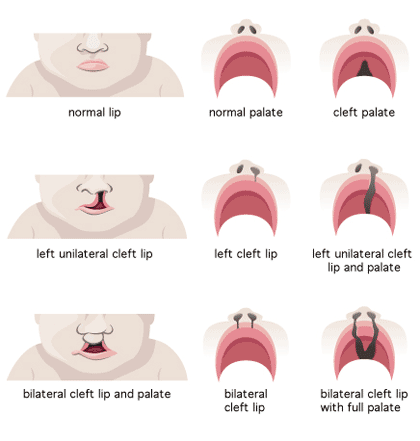
Cleft Lip & Palate Surgery | Arlington VA | Gainesville VA
 During the early stages of pregnancy, separate areas of a fetus’ face develop individually, and then eventually join together. This includes the left and right sides of the roof of your mouth, and your lips. In some situations, these different pieces don’t join together, and result in what is known as a “cleftâ€. When this separation occurs in the upper lip, a child has a “cleft lipâ€.
During the early stages of pregnancy, separate areas of a fetus’ face develop individually, and then eventually join together. This includes the left and right sides of the roof of your mouth, and your lips. In some situations, these different pieces don’t join together, and result in what is known as a “cleftâ€. When this separation occurs in the upper lip, a child has a “cleft lipâ€.
A completely formed lip is important for aesthetics, but also for suckling and forming certain speech sounds. When a child has a cleft lip, there is an opening in the upper lip between their mouth and nose. It looks as though the lip is split. The severity can range from a slight notch in the colored part of the lip, to a complete separation extending up to the nose. When there is a cleft on just one side, it’s known as a unilateral cleft. When the cleft is on both sides, it’s called a bilateral cleft.
A cleft in the gum (cleft alveolus) can also occur in association with a cleft lip. This can range from a small notch in the gum, to a complete separation into divided parts.
Cleft Palate
The palate is the roof of your mouth, and is made of bone and muscle covered by thin wet skin or mucosa. It separates your mouth from your nose. The palate is important for eating, since it stops food and liquids from entering into your nose. A cleft palate occurs when there is an opening in the roof of your mouth.
The back of your palate is known as the soft palate and the front is the hard palate. Children with a cleft palate can have either an opening at the back of the soft palate or an almost complete separation of the roof of the mouth (soft and hard palate).
Some babies with a cleft palate may have a small chin, and some may have difficulty breathing as a result. Cleft defects occur in approximately one out of every 800 babies.
Cleft Lip Treatment
Cleft lip surgery is generally performed when a child is about three months old. The surgery is performed to close the separation, restore muscle function, and create a normal shape of the upper lip. Nostril defects can also be improved during the procedure. In most cases, a separate surgery may be required.
Cleft Palate Treatment
A cleft palate is first treated with surgery when the child is between 8-12 months old before the development of speech. This can vary from child to child however. For instance, if a child has other associated health issues, the surgery may be delayed. Cleft palate surgery is used to close the gap or hole in the palate, reconnect the muscles in the soft palate, and restore function such as speech.Â
Cleft Alveolus Treatment
A cleft alveolus (cleft in in the gums) is treated when the child is 8-9 years old during the development of the canine. The surgery is performed to close the hole between the mouth and the nose and repair the gap in the bone supporting the teeth (alveolus) using bone graft. After the bone has healed, the gap in the teeth can be closed by moving the teeth via orthodontics or replaced with an implant.Â
What To Expect After Surgery
Once the palate is repaired, children will have an easier time swallowing. However, one out of five children will experience a partial split in the repair, which causes a new hole to form between the nose and mouth. If the hole is small, it can result in occasional minor leakage of fluids into the nose. However, if it is large, it can result in significant difficulty eating and speaking. The hole is known as a “fistula†and may require additional surgery in order to correct.
Contact Northern Virginia Surgical Arts in Arlington, Gainesville, or Manassas, VA today to setup an appointment to discuss cleft lip or cleft jaw surgery.